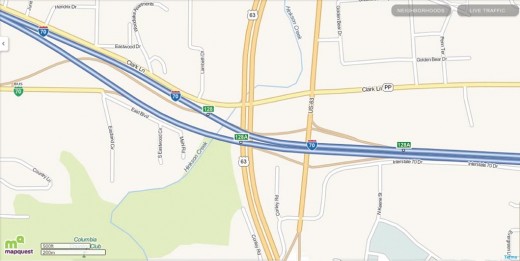Grappling with gridlock

 The future of the U.S. 63 and Interstate 70 intersection and surrounding area is up in the air — literally and figuratively.
The future of the U.S. 63 and Interstate 70 intersection and surrounding area is up in the air — literally and figuratively.
Case in point: To help relieve congestion, the Missouri Department of Transportation is considering building a massive flyover ramp so traffic from northbound 63 can bypass the current intersection and go directly onto westbound 70 at highway speeds. The ramp would be perched on stilts so it could go around and possibly over Mark’s Mobile Glass and other businesses.
But the funding and timing for that ramp and other nearby upgrades are anyone’s guess. The big wild card isn’t I-70, which could become a toll road to fund its own improvements. Instead, projects such as the flyover ramp could be funded and built separately, if need be. Their designers would use the Improve I-70 study (http://www.improvei70.org/) as a guide so the new infrastructure doesn’t have to be replaced if the interstate is widened.
“Even though there isn’t any funding available at the current time, you still want to be able to accommodate that with what you’re doing [now],” says Steve Engelbrecht, MoDOT Central District planning manager.
 Traffic congestion
Traffic congestion
If there’s one certainty, it’s that traffic in the 63-70 area will continue to grow simply because the east side of the city continues to add commercial and residential developments. Traffic on some area roads has increased significantly since the late 1990s. For example, in 1997, nearly 33,000 vehicles exited from eastbound I-70 onto Highway 63 each day, MoDOT says. By 2008, the daily count was nearly 43,000.
That traffic means high visibility for many nearby businesses, but it also creates a hassle for others, such as Socket Telecom, whose headquarters is at 2703 Clark Lane. “We see the Clark Lane corridor back up pretty bad around 5 p.m.,” says Carson Coffman, Socket president and COO. “In particular on Fridays, you are not able to pull out of our drive.”
Replacing the current 63-70 intersection with a more traditional cloverleaf design isn’t a viable option because it would require buying out some of the businesses that are a stone’s throw from both highways. Hence the flyover ramp proposal.
“This is a little different configuration than you might see for some interchanges,” Engelbrecht says. “You come up with a schematic that tries to miss as much as possible.”
Possible projects
Here’s a rundown of major projects that MoDOT and the Columbia Area Transportation Study Organization (CATSO) are considering for the area:
• The southbound Highway 63 bypass would get an exit ramp onto westbound I-70, eliminating the need for those vehicles to pass through the current intersection.
• A new I-70 overpass would connect Clark Lane to Business Loop 70.
• Ballenger Lane would be extended over I-70 to I-70 Drive Southeast and then on to St. Charles Road, reducing traffic both on Clark Lane and at the 63-70 intersection.
• Eastbound I-70 would get a cloverleaf-style exit ramp onto the northbound Highway 63 bypass, as well as a ramp onto the southbound Highway 63 bypass. Both would eliminate the need for those vehicles to pass through the current intersection.
• Business Loop 70 would be extended along East Boulevard and then connect to Conley Road. This project, which might break ground in the next couple of years, would provide an alternative for some travelers who currently pass through the 63-70 intersection.
A host of other, farther-flung projects — outlined in CATSO’s “2030 Transportation Plan” — also could alleviate congestion in the 63-70 area. One is the extension of Stadium Boulevard from Highway 63 to I-70 at Lake of the Woods, diverting some traffic away from the 63-70 area. Another is a new “northern loop” of arterial roads running from Ballenger Lane to Creasy Springs Road.
“Projects like the Brown School Road construction in Auburn Hills and the more recent improvements to Brown School Road west of Range Line Street-Missouri 763 are segments in the planned northern route,” says Timothy Teddy, a CATSO committee member and the city’s director of community development. “It won’t provide a bypass to get through Columbia in the same way an interstate ring would, but it will improve access and circulation of traffic on the north side of the city.”
Good for business?
Regardless of when and how Interstate 70 is upgraded, one aspect of that project appears certain at this point: It will remain in its current corridor, instead of following other proposals that would have rerouted somewhere to the north. That means gas stations, restaurants and other businesses in the U.S. 63 and I-70 area don’t have to worry about a new bypass loop siphoning off potential customers.
But if the flyover ramp and other proposed changes mean vehicles will be able to zip through that area, won’t they hurt businesses that cater to travelers? Not necessarily.
“Just like when they put the bypass in to get U.S. 63 around, those cars weren’t going to stop anyhow,” says Tom May, director of marketing at MFA Oil, whose Break Time convenience store sits between the U.S. 63 bypass and U. S. 63 connector. “It’s relieved congestion and made it easier for customers who do want to stop. Sometimes you see customer counts go up because there’s not so much congestion, and it’s easier for them to stop.”


